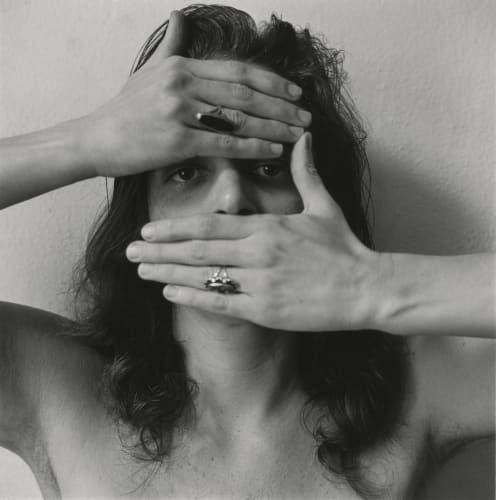When Melissa Shook was living in downtown New York City in the 1970s, the city was crime-ridden and on the brink of financial ruin. The second wave of the feminist movement permeated national consciousness. The groundbreaking book Our Bodies Ourselves was published in 1970 by the Boston Women’s Health Book Collective; Deep Throat made headlines when it came out in 1972. It was a charged moment for the cultural and political coverage of women’s bodies. Shook had become a single mother in 1971, and she began documenting and experimenting with her own body in front of the lens, questioning in her photographs whether the body can be separated from the self and seeking to understand her own power as a photographer and as a photographic subject.
In selections from her series Daily Self-Portraits 1972-1973, on view at Miyako Yoshinaga Gallery through October 15, Shook, who died in 2020, poses thoughtfully and plays in front of the camera, striking silly, mischievous, or offbeat poses and making enigmatic gestures: in a sequence of images from May and June 1973, she is naked, with a towel wrapped around her hair as if she’s just emerged from a shower, and she strikes a series of expressive, angular poses, arms and legs askew. In a group of closeups from March and April 1973, her hands cover her face in various ways: she pinches her nose, covers her mouth, or splays her fingers open on either side of her face. Another March 1973 sequence shows just her curving torso, a modern yet elegant appreciation of her form. In this series, Shook seems to be interrogating typical representations of women and examining conventions of femininity. (A parallel exhibition, Melissa Shook: Inside Out, is on view through October 29 at UMass Boston, where Shook taught photography for 31 years, and includes book-making, drawings, sculpture, and video art.)
Shook may also have sought to reclaim her body after creating a life. Although she went on to photograph her daughter for nearly 20 years in the Krissy series, Krissy appears in this show mainly as a specter: the scar on Shook’s stomach, the furrow in her brow or the circles under her eyes, the blocks on the floor, or the possible reason – perhaps – for this photographic investigation in the first place.


